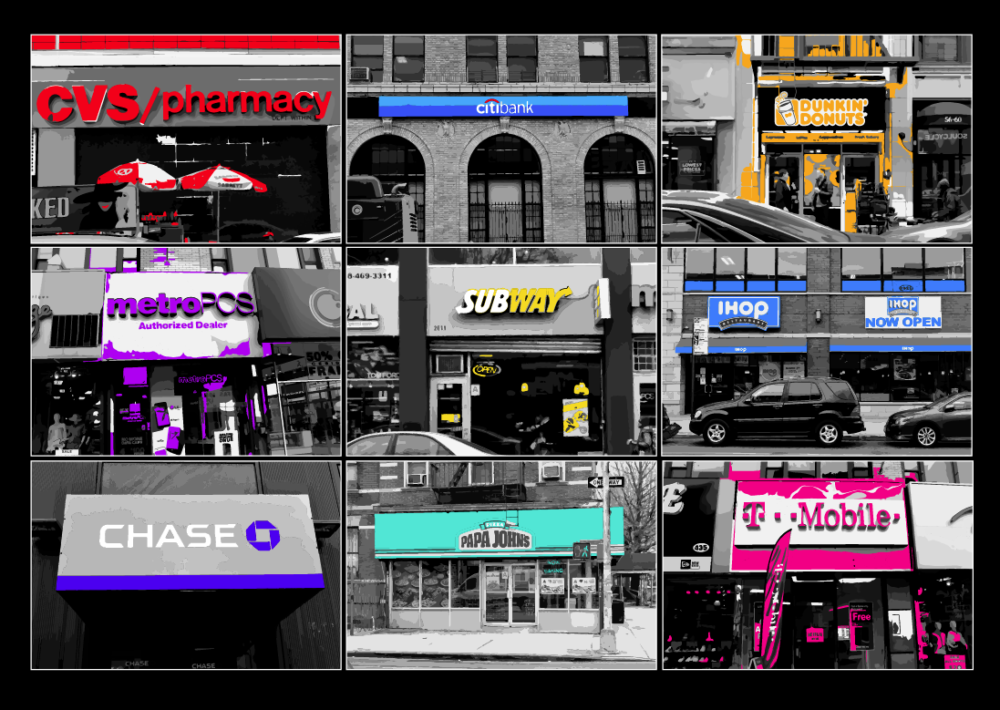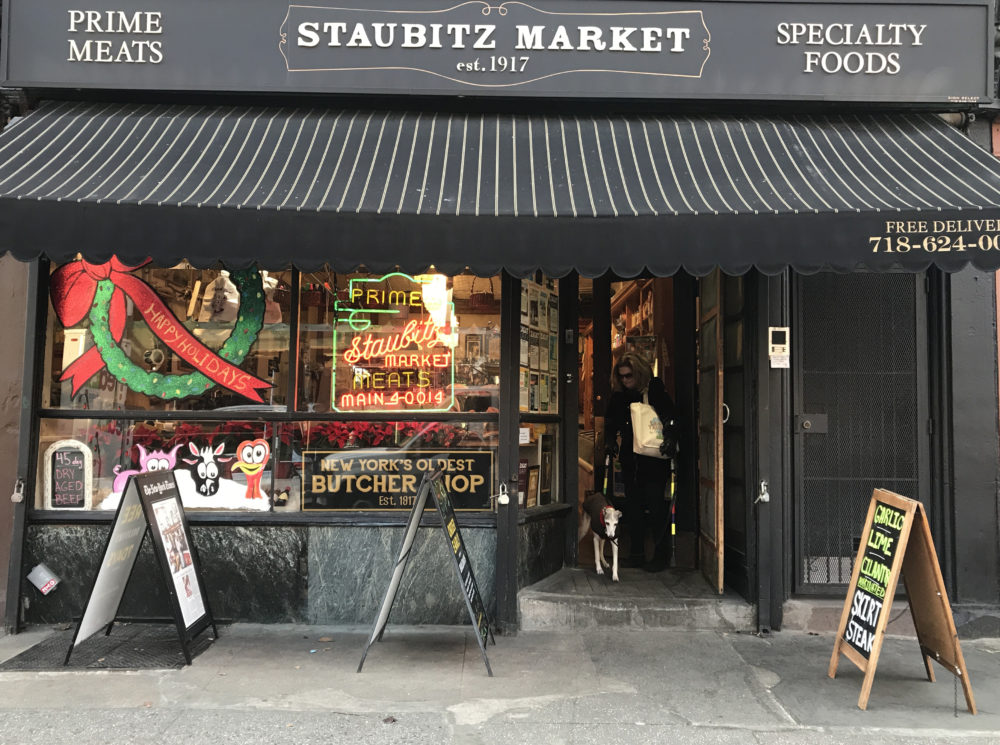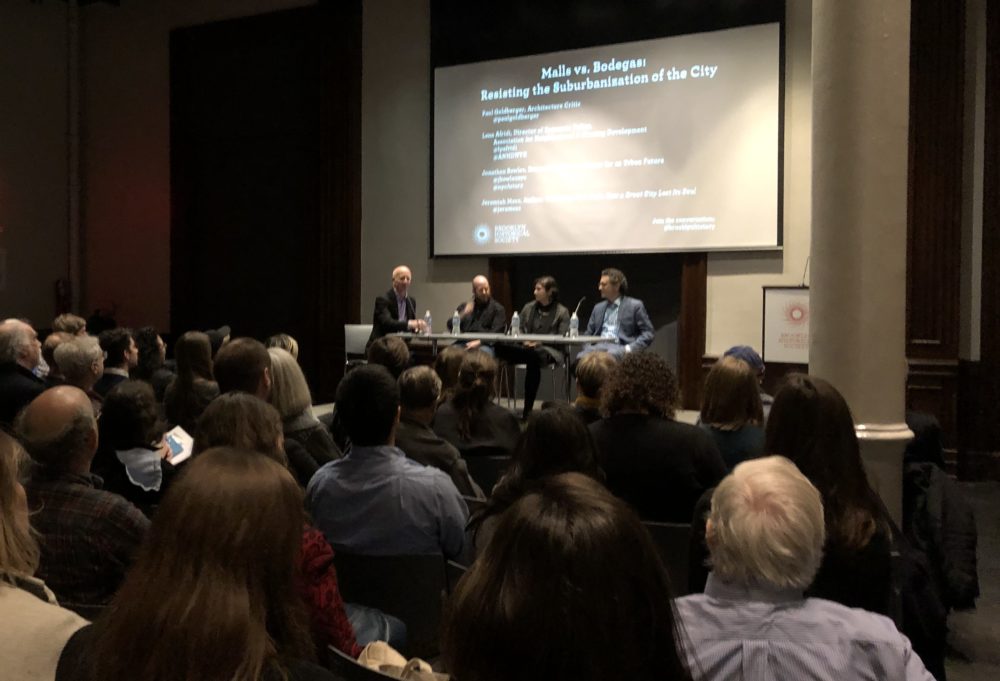Malls vs. Bodegas: Can the City Resist Becoming Suburban?
As the invasion of chain stores changes Brooklyn's character, a panel of urban experts has some sharp insights
(Illustration by Heather Jones. Photos by Arden Phillips)
From the days of street gangs ruling the Five Points to the nights of Guardian Angels patrolling subway cars swallowed whole by graffiti, New York City has a long history of substantive grit. Yet even in the darkest times, the city’s street life has been brightened by its distinctive storefronts and mom-and-pop shops.
Now the city’s edge has been rounded off, with safety and prosperity ascendant. But does that inevitably mean the rise of commercial conformity, with the mom-and-pops substantially replaced by national chain stores? The trend has been particularly notable in Brooklyn, which in 2017 saw the biggest percentage increase in the number of chain stores among the five boroughs, with 1,587 locations, a 3.1% increase from 2016, according to a report last year.
The recent announcement that Amazon, which has contributed to the decline of brick-and-mortar stores, is set to build a triumphant headquarters in Long Island City has been seen as another benchmark in New York’s transition from grime to gloss.
With all that in mind, last week the Brooklyn Historical Society hosted a panel discussion called “Malls vs. Bodegas: Resisting the Suburbanization of the City.” About 120 people poured into the society’s auditorium, situated in Brooklyn Heights, to hear a variety of takes on the city’s cultural shift from local-economy activists, researchers, and thought leaders. Paul Goldberger, the architecture critic and contributing editor to Vanity Fair, served as moderator. Among the highlights:
Fewer Customers, Rising Rents
Early on, the panel focused on potential causes for the disappearance of small businesses in the city, and landed on chain stores right off the bat.
“Twenty years ago there wasn’t a whole lot of big box, national retail in New York,” said Jonathan Bowles, executive director of the Center for an Urban Future, a think tank focused on New York City. “A few early [chain] retailers showed, boy, they can have a lot of success, ring up huge sales in New York. A lot of people didn’t think they could do that.”
New York has since experienced an invasion of national retailers, Bowles said, which landlords love for at least two reasons: the companies have the deep pockets to pay hight rents, and they’re generally reliable, having been vetted by years of success and expansion.

A mainstay: Staubitz Market in Cobble Hill, a butcher shop that has been in business for 101 years (Photo by Crary Pullen)
“And then, three or four years ago, on top of that trend, happened the Amazons, the Zappos, all the online shopping,” Bowles continued. “So we’re seeing all sorts of retail, small and large, that are really struggling to compete, particularly the merchandise retailers … but then it’s happening at the same time as landlords have gotten so used to these kinds of year-over-year, double-digit [rent] increases.”
Bowles said these conflicting cultural developments have helped to generate the glut of vacant storefronts, especially in Manhattan, where a recent study showed 20% of the borough’s retail spaces are unoccupied, up 13% from two years ago.
“People just aren’t shopping right now, there’s not enough customers, but a lot of the landlords haven’t recalibrated their expectations,” Bowles said. “They’re still thinking [like it’s] three years ago where a wave of national retailers are going to come in, and I think it’s changed a little bit.”
A New Opportunity?
Bowles thinks the tide may be turning. While his group’s data shows the number of chain stores ballooning even during the Great Recession, last year the city overall showed just a 1.8% expansion, despite the higher rate in Brooklyn. “Although food establishments continue to show strong growth, retailers that compete most directly with online outlets—such as shoe and electronics stores—have experienced significant contractions,” a summary of the center’s 2017 report said.
Though Bowles’s organization hasn’t released data for 2018 yet, he expects any additional uptick in the presence of chain retail in New York the past 12 months to be minimal, with traditional retailers continuing to be outpaced by food-focused businesses.
“I’ve never seen anything like it,” Bowles said. “I’ll just cite a few of the stores that I’ve seen with significant losses this past year: Aerosoles, Club Monaco, Nine West, Ralph Lauren, Claire’s, Best Buy, Radio Shack, Aeropostale, True Religion, Payless, Bolton’s, Strawberry, Sunglass Hut, Lens Crafters.”
Bowles also observed, “Even drugstores like Duane Reade and Rite Aid are down,” which compelled moderator Goldberger to quip: “Duane Reade has actually closed a store?”
Shortly after the audience’s laughter died down, Lena Afridi, director of economic policy at the Association for Neighborhood & Housing Development, an advocacy group focused on affordable housing and the building of neighborhood equity, pointed out a different side of the situation. Many of the retailers on Bowles’s list, like Strawberry and Payless, are relied on by low- and middle-income residents for affordable choices, she notes.

The panel discussion played to a full house last week at the Brooklyn Historical Society (Photo by Michael Stahl)
“When those options start to disappear, what does it mean [for those neighborhoods]?,” Afridi posed. Later, she said that her organization is looking to start a fund that will assist people in economically challenged areas to “build out commercial spaces at the bottom of affordable-housing buildings, to, instead of bringing Applebee’s to be an anchor tenant, bring, like, four small businesses from the area in.”
“That would make a huge difference,” Goldberger said.
But with even many national retail stores struggling in the five boroughs, and with all those vacant storefronts, panel members observed that some small businesses might be able to take advantage of a long-awaited softening of commercial rents, which have started to decline along some Brooklyn retail corridors.
“I just don’t think all those empty spaces are going to stay there,” Bowles said. “I think very soon we’re going to see more landlords understand that this is not what it was four years ago, in light of a lot of these online disruptions that we’re seeing. I think there could be some opportunities for independent businesses.”
Bowles then threw out the statistic that independent bookstores in Brooklyn are up 33% the past decade, which sparked some audience applause.
“I’m not saying it’s all of a sudden going to turn 180 degrees,” Bowles went on, “[but] I think there’s some opportunities in the vacancy crisis that we’re seeing.”
Still, as both Goldberger and Afridi pointed out, the rise in the number of independent bookstores—though encouraging and widely embraced—has been concentrated in just a few areas of the city. Afridi, a Queens native, said, “We have two in Queens that are independent; there are zero in the Bronx. So this conversation, when we talk about where are these things happening, we need to push [our] thinking out a little bit.”
A Psychological Shift?
Citing the packed house at the Brooklyn Historical Society and other evidence, Afridi observed that, on some level, there’s “a deep desire” for New Yorkers to revisit the city’s historic culture of personal, public connections. (Of course, commercial spaces help facilitate such encounters.)
Jeremiah Moss, author of both the book and popular blog called Vanishing New York, about hyper-gentrification and the loss of the city’s cherished, mom-and-pop commercial culture, emerged less hopeful for the future of the city’s storefronts—and its soul.
“I see this new psyche has come into New York City that didn’t used to be here, and it’s not just young people, it’s newcomers,” Moss, a practicing psychoanalyst whose legal name is Griffin Hansbury, said. “A lot of it has to do with New York being safer … If you came here, like I did, you accepted a certain level of risk because you had to be here for whatever reason, you had to leave the place you’d come from, and there was a desperation in that. But now you can be risk averse and come to New York.”
He believes that, thanks in part to the advent of smartphones, people who walk the streets of the city can now find themselves cocooned in their own “private bubble,” regardless of the foot traffic in front of them.
“If you interfere with that bubble,” Moss continued, “either they don’t see you—they bounce off you like a wind up toy—or they get irate, enraged [because] they want to have a frictionless experience.”
Online shopping is an extension of this frictionless experience, and both Moss and Goldberger bemoaned the stacks of delivered boxes lining their buildings’ hallways, forming obstacle courses they each have to navigate in order to arrive safely at their apartment doors.
Moss then quoted E.B. White, who said, “New Yorkers temperamentally don’t crave comfort and convenience—if they did they would live somewhere else.” Moss said sharply that New York’s transplants, who are retreating into their bubble of comfort and convenience, “should go live somewhere else.”
“If that’s what you want, above all, then New York’s not the place for you,” he continued. “Cities are not about ‘the easiest way,’ they’re about friction, and they’re about difference, and they’re about creation, and they’re about descent against the mainstream. They’re about a lot of things that are not about comfort and convenience.”
How do we solve this psychological shift?
“We need to shame our friends,” Moss said: Shame them into looking up on the sidewalk, where they should also walk on the right-hand side; into shopping at local, independent businesses; and into engaging with the 8-million-strong community around them.
“There are a lot of new people coming into New York, who don’t know how to do New York, and they need to be told how to do New York,” Moss said as the discussion neared a close. At that the audience applauded, and soon thereafter emptied into the streets and subways, with many of them passing rows of Christmas trees watched over by a young, bundled-up salesman, standing in the glow of a CVS store across the street.










